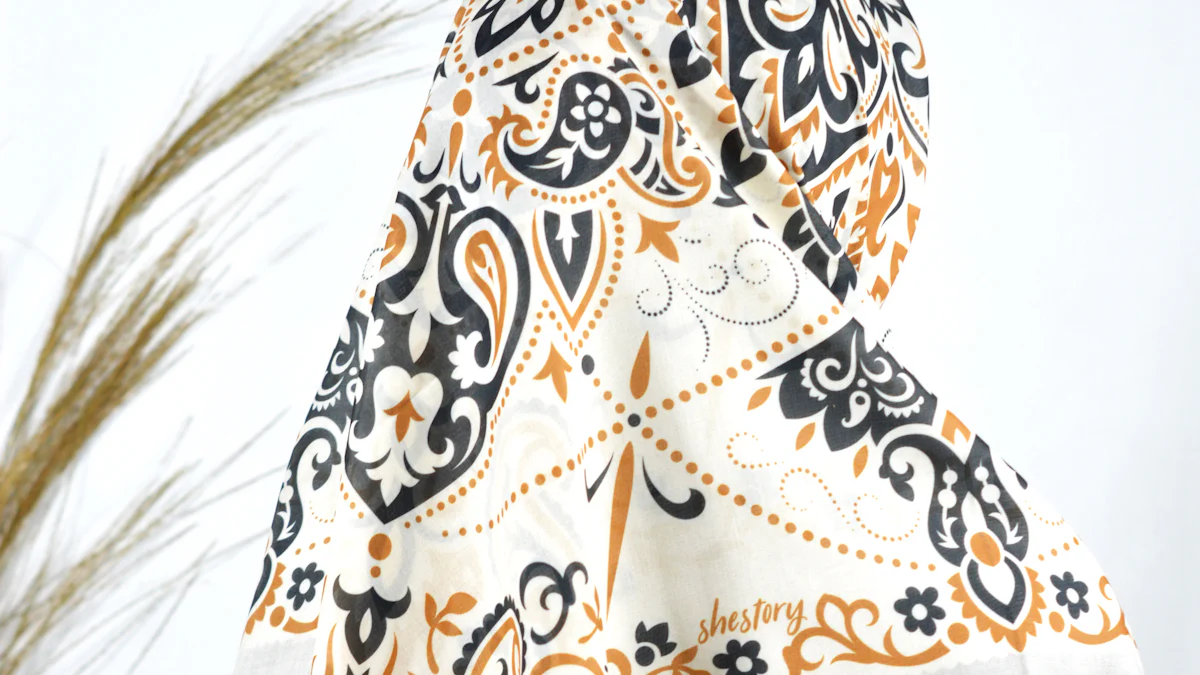
Scarves with loose weaves or knit patterns may shed more fibers, especially during initial wear or washing. The biggest culprit is wool, which pills and sheds more than other fabrics like acrylic, polyester, and viscose scarves. Learning how to stop polyester scarf from shedding can be crucial, as shedding can be intense but manageable. This blog aims to educate on practical tips to reduce shedding in polyester scarves and maintain their quality over time.
Proper Brushing Techniques
Use a Dog Shedding Brush
When it comes to reducing shedding in polyester scarves, using a Dog Shedding Brush can be highly effective. This type of brush is specifically designed to tackle loose fibers and prevent excessive shedding.
Benefits of Dog Shedding Brushes
- Efficiently removes loose fibers from the scarf
- Helps maintain the quality and appearance of the polyester material
- Reduces the amount of shedding during wear
How to Brush Correctly
- Start by gently brushing down the scarf with the dog shedding brush.
- Ensure you cover all areas of the scarf to remove any loose fibers effectively.
- Brush in one direction to prevent tangling or damaging the fabric.
Use a Natural Bristle Brush
In addition to a dog shedding brush, incorporating a Natural Bristle Brush into your scarf maintenance routine can further minimize shedding.
Advantages of Natural Bristle Brushes
- Gentle on delicate fabrics like polyester scarves
- Helps redistribute natural oils, keeping the scarf soft and smooth
- Prevents static buildup that can lead to more shedding
Brushing Method
- Gently run the natural bristle brush along the length of the scarf.
- Focus on areas where shedding is more prominent, such as edges or corners.
- Regularly brush your polyester scarf before wearing it to reduce shedding.
How to Stop Polyester Scarf from Shedding
To effectively combat shedding in polyester scarves, establishing a proper brushing routine is essential.
Regular Brushing Schedule
- Set aside time each week to brush your scarf with either a dog shedding brush or natural bristle brush.
- Consistent brushing helps remove loose fibers and prevents them from falling out during wear.
Tips for Effective Brushing
- Avoid applying too much pressure while brushing to prevent damage to the fabric.
- Always brush in a gentle, downward motion to detangle fibers without causing breakage.
- Store your scarves properly after brushing to keep them free from dust and debris.
Washing Instructions

Follow Recommended Temperatures
To maintain the quality of polyester scarves, it is essential to wash them at the recommended temperatures. The correct temperature ensures that the scarf is cleaned effectively without causing damage to the fabric.
Importance of Correct Temperature
- Washing your scarf at the recommended temperature helps prevent shrinkage and color fading.
- Polyester scarves washed at the right temperature retain their shape and softness for longer periods.
- By following the temperature guidelines, you can avoid excessive shedding and maintain the scarf’s overall appearance.
How to Wash at Recommended Temperature
- Check the care label on your polyester scarf for specific washing instructions regarding temperature.
- Set your washing machine to a fine wash program at 30 degrees Celsius for optimal results.
- Use a gentle detergent suitable for delicate fabrics to ensure thorough yet gentle cleaning.
Use Gentle Detergents
Choosing the right detergent is crucial when washing polyester scarves to reduce shedding and preserve their quality over time.
Benefits of Gentle Detergents
- Gentle detergents help protect the fibers of polyester scarves from damage during washing.
- Using a mild detergent maintains the softness and vibrancy of the scarf’s colors.
- Gentle detergents are less likely to cause irritation or allergic reactions on sensitive skin.
How to Choose the Right Detergent
- Opt for a detergent specifically labeled as suitable for delicate fabrics like polyester.
- Look for detergents that are free from harsh chemicals, fragrances, and dyes to prevent any adverse effects on the scarf.
- Consider using liquid detergents over powders as they dissolve more easily, reducing residue buildup on the fabric.
Add Vinegar to the Wash
An effective way to minimize shedding in polyester scarves is by incorporating vinegar into your washing routine.
How Vinegar Helps
- Vinegar acts as a natural fabric softener, helping maintain the suppleness of polyester scarves.
- The acidity in vinegar helps break down any residue left by detergents, preventing fiber tangling and shedding.
- Adding vinegar during rinsing can also restore brightness to colored scarves while reducing static cling.
Proper Vinegar Usage
- Pour half a cup of distilled white vinegar into your washing machine during the rinse cycle.
- Ensure that you do not mix vinegar with bleach or other cleaning agents to avoid chemical reactions.
- Let your polyester scarf go through an additional rinse cycle if needed after adding vinegar for thorough cleansing.
Post-Wash Care
Hang and Dry Outside
Air drying polyester scarves is a crucial step in the post-wash care routine. By opting for air drying instead of using a dryer, you can prevent potential damage to the delicate fabric and ensure that your scarf maintains its quality over time.
Benefits of Air Drying
- Preserves the integrity of the polyester material without subjecting it to excessive heat.
- Prevents shrinking and discoloration that may occur when using a dryer.
- Allows the scarf to naturally dry, reducing the risk of damage from high temperatures.
Correct Hanging Method
- Choose a well-ventilated area outside to hang your washed polyester scarf.
- Avoid direct sunlight exposure to prevent color fading and maintain the vibrancy of the fabric.
- Use clothespins or hangers to secure the scarf in place while it dries thoroughly.
- Ensure that the scarf hangs freely without any folds or creases to promote even drying.
- Periodically check on the scarf during the drying process to assess its moisture level and adjust as needed.
Use a Vinegar Solution
Incorporating a vinegar solution into your post-wash care routine can offer additional benefits for maintaining your polyester scarves. Vinegar not only helps set dye but also acts as a natural softener, keeping your scarves supple and vibrant.
How Vinegar Sets Dye
- The acidity in vinegar aids in setting the dye molecules into the fibers of polyester scarves, preventing color bleeding during future washes.
- By using vinegar during rinsing, you can ensure that your scarf retains its original color intensity for an extended period.
Soaking Method
- Prepare a mixture of cold water and distilled white vinegar in a clean container at a ratio of 1:1.
- Submerge your washed polyester scarf in the vinegar solution, ensuring that it is fully immersed for optimal results.
- Allow the scarf to soak for approximately 15-20 minutes to allow the vinegar to penetrate the fibers effectively.
- After soaking, gently squeeze out excess liquid from the scarf without wringing it to avoid damaging the fabric.
- Proceed with air drying as per the recommended method for best outcomes.
Additional Tips
Freeze the Scarf
How Freezing Helps
- Freezing your polyester scarf can be a simple yet effective method to reduce shedding. By freezing the scarf, you can help stiffen the fibers and prevent them from shedding excessively during wear. The cold temperature of the freezer can also help lock in any loose fibers, reducing the shedding process once the scarf is thawed.
Freezing Method
- Fold your washed polyester scarf neatly to avoid creases.
- Place the folded scarf in a Ziploc bag to protect it from moisture.
- Seal the bag securely and put it in the freezer for approximately 24 hours.
- After 24 hours, remove the scarf from the freezer and let it thaw at room temperature.
- Gently shake out the scarf to loosen any frozen fibers before wearing it.
Use Fabric Conditioner
Benefits of Fabric Conditioner
- Incorporating fabric conditioner into your washing routine can help soften polyester scarves and reduce shedding. Fabric conditioner works by coating the fibers of the scarf, making them smoother and less prone to tangling or shedding. Additionally, fabric conditioner can add a pleasant scent to your scarves, enhancing their overall freshness.
Proper Usage
- After washing your polyester scarf with a gentle detergent, prepare a diluted solution of fabric conditioner.
- Submerge the washed scarf in the fabric conditioner solution for a few minutes to allow the product to penetrate the fibers.
- Gently squeeze out excess liquid from the scarf without wringing it to maintain its shape.
- Proceed with air drying as recommended to ensure that the fabric conditioner is fully absorbed by the fibers.
- Once dry, give your polyester scarf a light shake to fluff up the fibers and remove any excess residue.
Avoid High Heat
Effects of High Heat
- Exposing polyester scarves to high heat during washing or drying can lead to increased shedding and damage to the fabric. High temperatures can cause synthetic fibers like polyester to weaken and break down, resulting in excessive shedding over time. To maintain the quality and longevity of your scarves, it is crucial to avoid high heat settings when caring for them.
Recommended Drying Settings
- When drying your polyester scarves, opt for low heat settings on your dryer or air dry them naturally.
- Avoid using high heat settings that can cause shrinkage and deformation of the fabric.
- If using a dryer, set it on a delicate or low-heat cycle to prevent damage and minimize shedding.
- Check on your scarves periodically during drying to ensure they are not exposed to excessive heat for extended periods.
- By following these recommended drying settings, you can preserve the integrity of your polyester scarves and reduce shedding effectively.
By incorporating these additional tips into your care routine for polyester scarves, you can effectively minimize shedding and prolong their lifespan while enjoying their softness and vibrancy with each wear.
Anecdotal Evidence:
“I have washed my favorite polyester scarf following these tips diligently, including freezing it overnight as suggested here! The results were amazing—the shedding reduced significantly after wearing it today! Thank you for sharing such valuable advice.”
Recapping the essential points shared in this blog, proper care techniques play a vital role in reducing shedding and maintaining the quality of polyester scarves. By following the recommended brushing methods, washing instructions, and post-wash care routines, individuals can effectively minimize shedding and prolong the lifespan of their scarves. It is crucial to prioritize these tips for better scarf maintenance to enjoy long-lasting softness and vibrancy in every wear. Embrace these practices to ensure your polyester scarves remain shedding-free and retain their original charm.
Post time: Jun-18-2024
